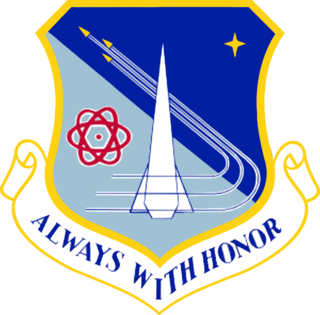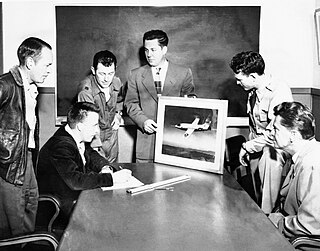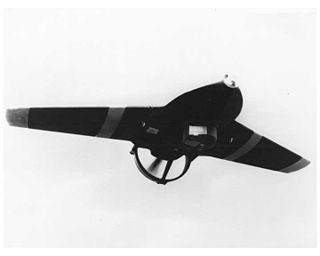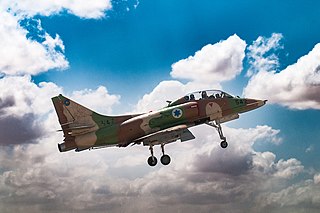
A fixed-wing aircraft is a heavier-than-air aircraft, such as an airplane, which is capable of flight using aerodynamic lift. Fixed-wing aircraft are distinct from rotary-wing aircraft, and ornithopters. The wings of a fixed-wing aircraft are not necessarily rigid; kites, hang gliders, variable-sweep wing aircraft, and airplanes that use wing morphing are all classified as fixed wing.

A flight simulator is a device that artificially re-creates aircraft flight and the environment in which it flies, for pilot training, design, or other purposes. It includes replicating the equations that govern how aircraft fly, how they react to applications of flight controls, the effects of other aircraft systems, and how the aircraft reacts to external factors such as air density, turbulence, wind shear, cloud, precipitation, etc. Flight simulation is used for a variety of reasons, including flight training, the design and development of the aircraft itself, and research into aircraft characteristics and control handling qualities.

A flight surgeon is a military medical officer practicing in the clinical field of aviation medicine, which is also occasionally known as flight surgery.

Aerial warfare is the use of military aircraft and other flying machines in warfare. Aerial warfare includes bombers attacking enemy installations or a concentration of enemy troops or strategic targets; fighter aircraft battling for control of airspace; attack aircraft engaging in close air support against ground targets; naval aviation flying against sea and nearby land targets; gliders, helicopters and other aircraft to carry airborne forces such as paratroopers; aerial refueling tankers to extend operation time or range; and military transport aircraft to move cargo and personnel.

A conventional fixed-wing aircraft flight control system (AFCS) consists of flight control surfaces, the respective cockpit controls, connecting linkages, and the necessary operating mechanisms to control an aircraft's direction in flight. Aircraft engine controls are also considered flight controls as they change speed.

Elevators are flight control surfaces, usually at the rear of an aircraft, which control the aircraft's pitch, and therefore the angle of attack and the lift of the wing. The elevators are usually hinged to the tailplane or horizontal stabilizer. They may be the only pitch control surface present, and are sometimes located at the front of the aircraft or integrated into a rear "all-moving tailplane", also called a slab elevator or stabilator.

A stabilator is a fully movable aircraft horizontal stabilizer. It serves the usual functions of longitudinal stability, control and stick force requirements otherwise performed by the separate parts of a conventional horizontal stabilizer and elevator. Apart from reduced drag, particularly at high Mach numbers, it is a useful device for changing the aircraft balance within wide limits, and for reducing stick forces.

Officer Training School (OTS) is a United States Air Force and United States Space Force commissioning program located at Maxwell Air Force Base in Montgomery, Alabama.
Flight testing is a branch of aeronautical engineering that develops specialist equipment required for testing behaviour and systems of aircraft or testing the atmospheric phase of launch vehicles and reusable spacecraft. Instrumentation systems are developed using proprietary transducers and data acquisition systems. Data is sampled during the flight of an aircraft, or atmospheric testing of launch vehicles and reusable spacecraft. This data is validated for accuracy and analyzed to further modify the vehicle design during development, or to validate the design of the vehicle.

Turkish Aerospace Industries Inc. is the center of technology in design, development, manufacturing, integration of aerospace systems, modernization and after sales support in Turkey.

Unmanned aerial vehicles (UAVs) include both autonomous drones and remotely piloted vehicles (RPVs). A UAV is capable of controlled, sustained level flight and is powered by a jet, reciprocating, or electric engine. In the twenty-first century, technology reached a point of sophistication that the UAV is now being given a greatly expanded role in many areas of aviation.

Colonel Jackie Lynwood Ridley was an aeronautical engineer, USAF test pilot and chief of the U.S. Air Force's Flight Test Engineering Laboratory. He helped develop and test many Cold War era military aircraft. He worked on the Bell X-1, the first aircraft to achieve supersonic flight, and was highly respected among fellow test pilots, most notably Chuck Yeager, for his engineering skills.
The GBU-44/B Viper Strike glide bomb was a GPS-aided laser-guided variant of the Northrop Grumman Brilliant Anti-Tank (BAT) munition which originally had a combination acoustic and infrared homing seeker. The system was initially intended for use from UAVs, and it was also integrated with the Lockheed AC-130 gunship, giving that aircraft a precision stand-off capability. The Viper Strike design is now owned by MBDA.

U.S. Air Force aeronautical ratings are military aviation skill standards established and awarded by the United States Air Force for commissioned officers participating in "regular and frequent flight", either aerially or in space, in performance of their duties. USAF aeronautical badges, commonly referred to as "wings" from their shape and their historical legacy, are awarded by the Air Force in recognition of degrees of achievement and experience. Officers earning these badges and maintaining their requirements are classified as rated officers and receive additional pay and allowances.
The First European Air Traffic Controller Selection Test (FEAST) is a tool that helps Air Navigation Service Providers (ANSPs) identify the most suitable candidates for the job of air traffic controllers. FEAST was designed by and made available by (EUROCONTROL), the European Organisation for the Safety of Air Navigation. It is used by 44 organisations, including civil and military European Air Navigation Service Providers and certified ATC aviation training academies and universities.

The Lockheed MQM-105 Aquila (Eagle) was the first small battlefield drone developed in the United States during the 1970s to act as a target designator for the US Army.

The Polish Air Force Academy is located in Dęblin, eastern Poland. Established in 1927 during the interwar period, the Polish Air Force University is an accredited university for the undergraduate education of officers for the Polish Air Force.

The Israeli Air Force Flight Academy trains aircrew to operate Israeli Air Force aircraft, qualifying fighter, helicopter and transport pilots as well as combat and transport navigators.

The Federal Office for Defence Procurement (Armasuisse) is a federal agency of the Swiss Confederation. It is the procurement organization for armaments of Switzerland and is affiliated with the Federal Department of Defence, Civil Protection and Sport.
An autonomous aircraft is an aircraft which flies under the control of on-board autonomous robotic systems and needs no intervention from a human pilot or remote control. Most contemporary autonomous aircraft are unmanned aerial vehicles (drones) with pre-programmed algorithms to perform designated tasks, but advancements in artificial intelligence technologies mean that autonomous control systems are reaching a point where several air taxis and associated regulatory regimes are being developed.
















